Buzby - make someone happy !

This article first appeared in the Telecommunications Heritage Journal, Issue Number 71, Summer 2010 and is reproduced with the permission of the Telecommunications Heritage Group.
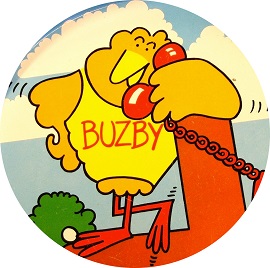
Is it a bird? Is it a plane? No, it’s Buzby! Love him or loathe him, there is no question that an orange and yellow cartoon bird proved to be a tremendous hit with the general public and an enormous success for the Post Office and later British Telecom.
Buzby was hatched in May 1976 at a time when the Post Office had raised telephone tariffs twice in quick succession and concern was being aired about the impact that this was having on both existing and future customers. Something had to be done and the first response was a TV advert that featured a 10p coin rolling across the screen to stress the value for money of a cheap rate call. However, a more sustainable, memorable and endearing campaign was needed. Celebrities were considered but the problem with them is that their status waxes and wanes and you either love them or hate them. Cartoon characters on the other hand are more neutral and can be made to appeal equally to both young and old. So along came Buzby, a yellow cartoon bird who lived up on the telephone wires.
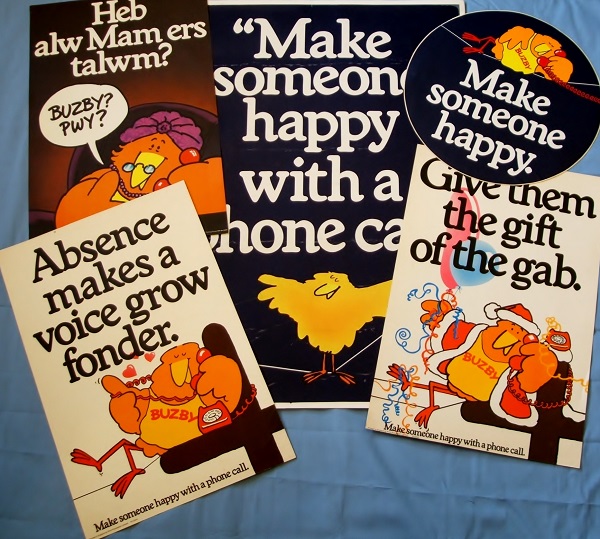
In the first instance, Buzby encouraged us to “make someone happy with a cheap rate phone call” but this soon changed to the catchier, “make someone happy”. Interestingly, when you look at the Buzby campaign, you can see that marketing of the telephone was now based, not on the cost alone but rather, more on the social benefits of keeping in touch with family and friends. Buzby was often featured talking to his mother thereby making us all feel a little guilty about whether we keep in touch as often as we should.
The voice of Buzby was provided by the well known actor Bernard Cribbins who was a household name as a Carry On film star, a regular on The Good Old Days, Mr Perks in the Railway Children, and the Wombles. Today, he remains a favourite of youngsters thanks to his role as Donna Noble’s granddad in Doctor Who. In addition to television, Buzby featured on telephone bills, the sides of GPO vans, posters, in children’s books and games, on mugs, badges and even an illuminated sign in Piccadilly Circus; Buzby was everywhere!
I never cease to be amazed by the range and diversity of Buzby memorabilia. Posters come in all shapes and sizes. Figure 1 shows several examples including a Christmas themed one in which Buzby says, “Give them the gift of the gab”, a love themed one which proclaims, “Absence makes the voice grow fonder”, and one in Welsh in which Buzby’s mother is answering the phone and saying, “Buzby who?”
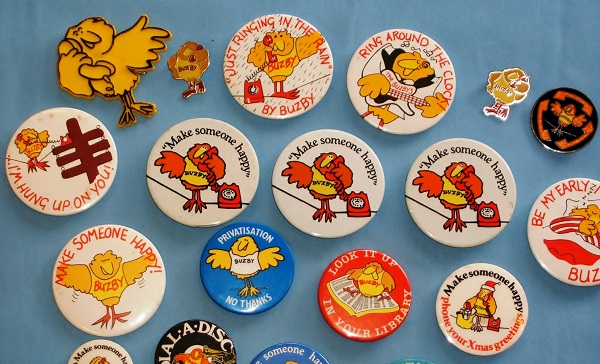
The range of Buzby badges is huge as illustrated in figure 2. In addition to the fairly standard, “Make someone happy” badge, we have “Hung up on you”, “Be my early morning Buz”, “Just ringing in the rain”,“Ring around the clock”, a Christmas badge, one badge promoting local libraries, and another, the dial a disc service. There was also a Buzby and Junior Buzby club each of which had its own badges and newsletters. Also buried in this collection is a rather interesting badge that shows Buzby, wings outstretched, proclaiming, “Privatisation, No thanks”. This is clearly protesting against the privatisation of British Telecom in 1984 but who produced it?
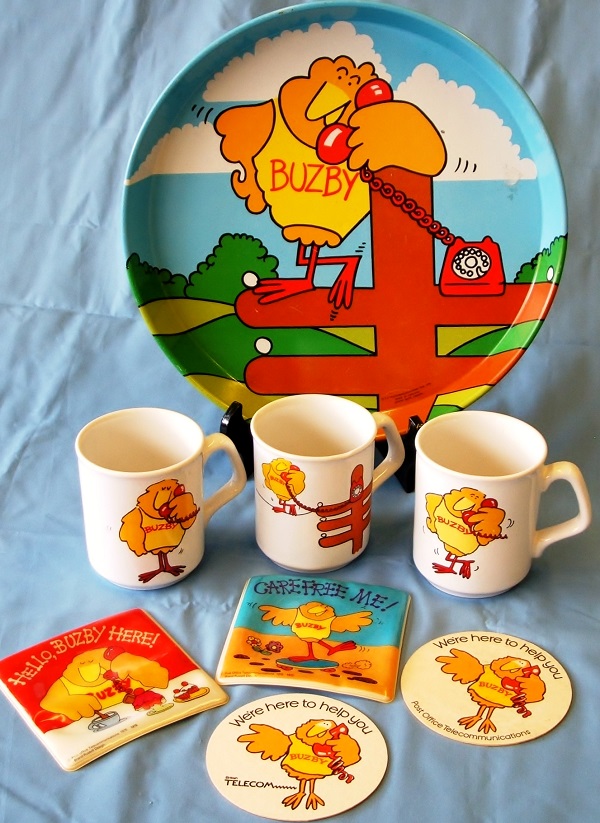
Corporate stationery also featured Buzby. Figure 3 shows the back of an envelope that was used to post your payment cheque and a new telephone number card for sending to family and friends. Household items didn’t escape either. Figure 4 shows three Buzby mugs, each of which features Buzby in a different pose but which all carry the same “Make someone happy” slogan. To carry your mugs there was a splendid circular Buzby metal tray and some rather nice Buzby coasters to protect your table top but if you prefer a different sort of drink altogether then there were beer mats too!
For many people in the late 1970s, the telephone remained a luxury and so saving up to pay your bill was important. In figure 5 we see two nice Buzby money boxes; a ceramic one moulded in the shape of Buzby and the other a metal telephone box with Buzby inside making a call. Finally, in figure 6 we can see several more everyday items including a Buzby message pad, a Buzby eraser in the shape of a letter ‘B’, a key ring and a wind up plastic toy that walks.
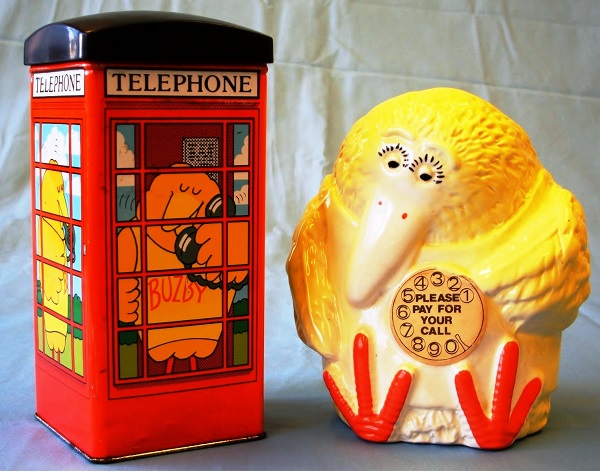
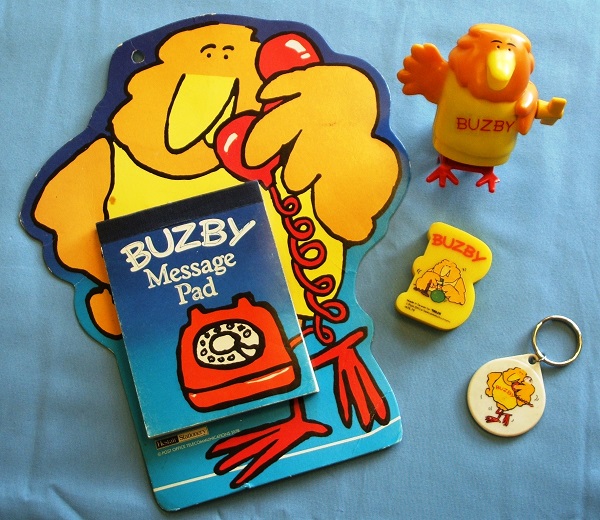
The Buzby campaign was not only very effective at marketing the telephone but also spawned an incredibly successful range of merchandise. Buzby finally departed our world in the early 1980s to be replaced by a Jewish grandmother and her extended family. Maureen Lipman’s Beattie featured in several highly successful television adverts and is perhaps best remembered for proclaiming “He gets an ology and he says he’s failed” when she hears that her grandson Anthony has failed all of his exams except for pottery and sociology. “You get an ology and you’re a scientist!”
This article has been illustrated using examples of Buzby memorabilia taken from the telecommunications artefact collection maintained at the University of Salford. You can see our full range of Buzby memorabilia under Marketing within the Historical section of this website.
Further reading:
[1] “How Buzby was hatched”, R M Stanley, Post Office Telecommunications Journal, Volume 29, Issue 2, Summer 1977
[2] “Into the 1970s”, BT Connected-Earth, available online.

Follow on social media .....